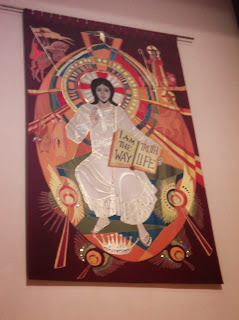Visiting York
Since yesterday was such a long tiring day, we changed our plan for a walk to Robin Hood's Bay today and decided to spend the day in York instead. Gillian suggested that we should use the Park & Ride facility so we parked at Monks Cross and caught the bus into York. We found this to be a quick, cheap and stress-free way to travel.
Our first stop was Fairfax House, a fine Georgian townhouse whose original owner was Viscount Fairfax. In the twentieth century it was turned into a dancehall and cinema so one of the most interesting aspects now was to discover how the restoration had been undertaken. Walls which had been removed were replaced, red paint was painstakingly removed from the highly decorated plaster ceilings, a cantilever staircase was rebuilt and much other work was done to restore it to its Georgian splendour.
Next we visited the nearby Clifford's Tower, the original stronghold for the city, and enjoyed panoramic views from the top of the castle walls.
Gillian had mentioned that some people enjoyed the stained glass windows at St Michael's church more than those at York Minster so when we passed St Michael's we decided to go in. This particular St Michael's turned out to be the Spurriergate Centre, a church which had been deconsecrated and turned into a fairtrade restaurant and cafe where pastoral services (conversation and counselling) were also offered. The stained glass windows and reredos (decoration behind the altar) were still in place and it was wonderful to see a former church being used in such a vibrant and worthwhile way.
We stopped for lunch at Bennetts and sat at an outside table with a marvellous view of York Minster.
St Michael le Belfrey church was next to the Minster and, realising that this must have been the 'St Michaels' that Gillian had meant, we went inside. The windows were indeed beautiful, some dating from 1330, and it would appear from their video that this is a strong community church with an enthusiastic outreach program.
We then entered York Minster and stayed a while in the free roped-off area at the back, absorbing the atmosphere and appreciating the beauty of the soaring gothic arches. We happened to be there at the time of day when a minister announced a time of prayer and the crowd of visitors became silent and respectful.
Walking further around the Minster precinct, we next visited the Treasurer's House, a property which was owned by a wealthy gentleman, Mr Frank Green from 1897. It was still furnished and decorated exactly as it was when Frank bequeathed it to the National Trust in 1930; in fact he threatened to return to haunt the house if any furniture was ever moved! Each room was decorated beautifully in whatever style appealed to Frank at the time - quite an eccentric and eclectic collection.
 |
| The Great Hall, Treasurer's House |
Feeling that we had earned a treat, we returned to Bennetts for some lemon drizzle cake and drinks before taking a walk around a section of the York city walls. Then on the way back to our Park & Ridre bus we found a shop called Christmas Angels and had some fun choosing Christmas decorations.
 |
| The Shambles, York |


















































